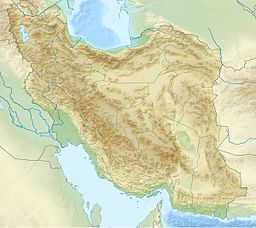
Back بحيره هامون ARZ Hamun gölü Azerbaijani Хамун Byelorussian Хамун Bulgarian Hamun Lake CEB Jezero Hámún Czech Hamun-See German Λίμνη Χαμούν Greek Hamun-lago Esperanto Lago Hamún Spanish
| Hāmūn-e Helmand | |
|---|---|
 Children playing around the Chah Nimeh reservoirs, to the southeast of the lake, 2018 | |
| Location | southeast Iran, southwest Afghanistan |
| Coordinates | 30°50′N 61°40′E / 30.833°N 61.667°E |
| Primary inflows | Helmand River |
| Basin countries | Afghanistan / Iran |
| Official name | Hamun-e-Saberi & Hamun-e-Helmand |
| Designated | 23 June 1975 |
| Reference no. | 42[1] |
Lake Hāmūn (Persian: دریاچه هامون, Daryāche-ye Hāmūn; Pashto: هامون ډنډ), or the Hamoun Oasis, is a seasonal lake and wetlands in the endorheic Sīstān Basin in the Sistan region on the Afghanistan–Iran border. In Iran, it is also known as Hāmūn-e Helmand, Hāmūn-e Hīrmand, or Daryāche-ye Sīstān ("Lake Sīstān").[2]
Hāmūn is a generic term which refers to shallow lakes (or lagoons), usually seasonal, that occur in the deserts of southeast Iran and adjacent areas of Afghanistan and Pakistan as a product of snowmelt in nearby mountains in spring. The term Hāmūn Lake (or Lake Hāmūn) equally applies to Hāmūn-e Helmand[2] (entirely in Iran), as well to the shallow lakes Hāmūn-e Sabari and Hāmūn-e Puzak, which extend into the territory of present-day Afghanistan with the latter almost entirely inside Afghanistan.
The Hamun is fed by numerous seasonal water tributaries; the main tributary is the perennial Helmand River, which originates in the Hindu Kush mountains in Afghanistan. In modern times, and prior to the existence of the dams for agricultural irrigation, spring floods would bring into existence much larger lakes.[3]
- ^ "Hamun-e-Saberi & Hamun-e-Helmand". Ramsar Sites Information Service. Retrieved 25 April 2018.
- ^ a b "GeoNames.org". www.geonames.org. Retrieved 11 April 2018.
- ^ Editorial Staff (2020-04-01). "Lake Hamun Biosphere Reserve & Life in It". Destination Iran Tours. Retrieved 2020-07-25.
